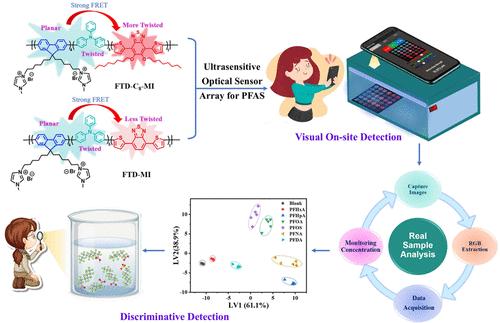基于分子工程的共轭聚合物中聚集诱导发射和FRET机制的协同集成,用于超灵敏、快速和判别全氟烷基物质的检测
IF 6.7
1区 化学
Q1 CHEMISTRY, ANALYTICAL
引用次数: 0
摘要
持久性有机污染物(全氟烷基物质)在全球范围内对水体的污染引起了重大的社会关注,强调迫切需要制定快速、超痕量和现场检测的智能战略。共轭聚合物(CPs)是一种特殊的荧光传感材料,具有信号放大特性,但其性能往往受到传统的聚集引起的猝灭(ACQ)效应的阻碍。在此,我们提出了两种受体工程聚集诱导发射(AIE)主动CPs (FTD-MI和FTD-C8-MI),结合了高效的Förster共振能量转移(FRET)机制,用于超低检测PFAS。FTD-MI表现出关闭(青色到深色)的荧光响应,而FTD-C8-MI对PFAS表现出比例(青色到红色)的响应,这是由于AIE和有效的链间FRET的协同作用,在结合时的静电和疏水相互作用的促进下。两种CPs在亚纳摩尔水平上对最丰富的全氟辛酸(PFOA)和全氟辛烷磺酸(PFOS)表现出优异的灵敏度。通过实验和仿真研究对其传感机理进行了深入的研究。此外,建立了一种结合机器学习算法的光学传感器阵列,用于六种类型的PFAS的判别检测。最后,开发了便携式智能手机平台和定制的“应用程序”,用于实时,现场和半定量分析实际水样中的PFAS。因此,通过提供敏感、便携、成本效益高和用户友好的解决方案,这项工作为监测PFAS污染、确保水安全和减少对公众健康的风险提供了强有力的工具。本文章由计算机程序翻译,如有差异,请以英文原文为准。

Synergistic Integration of Aggregation-Induced Emission and FRET Mechanisms in Conjugated Polymers via Molecular Engineering for Ultrasensitive, Rapid, and Discriminative Detection of Perfluoroalkyl Substances
The global contamination of water bodies by persistent organic pollutants (perfluoroalkyl substances (PFAS)) has generated significant societal concern, emphasizing the urgent need for smart strategies for their rapid, ultratrace, and on-site detection. Conjugated polymers (CPs) are exceptional fluorescence sensing materials with signal-amplification properties, yet their performance is often hindered by a conventional aggregation-caused quenching (ACQ) effect. Herein, we present two acceptor-engineered aggregation-induced emission (AIE)-active CPs (FTD-MI and FTD-C8-MI) integrated with efficient Förster resonance energy transfer (FRET) mechanisms for ultralow detection of PFAS. FTD-MI exhibits a turn-off (cyan to dark) fluorescence response, while FTD-C8-MI shows a ratiometric (cyan to red) response to PFAS due to the synergistic effect of AIE and efficient interchain FRET, facilitated by electrostatic and hydrophobic interactions upon binding. Both CPs demonstrate excellent sensitivity at the subnanomolar level toward the most abundant PFAS, perfluorooctanoic acid (PFOA), and perfluorooctanesulfonic acid (PFOS). The sensing mechanism has been thoroughly investigated by both experimental and simulation studies. Additionally, an optical sensor array coupled with machine learning algorithms is established for the discriminative detection of six types of PFAS. Finally, a portable smartphone platform with a custom-designed “app” was developed for real-time, on-site, and semiquantitative analysis of PFAS in actual water samples. Thus, by providing a sensitive, portable, cost-effective, and user-friendly solution, this work offers a powerful tool for monitoring PFAS pollution, ensuring water safety, and reducing risks to public health.
求助全文
通过发布文献求助,成功后即可免费获取论文全文。
去求助
来源期刊

Analytical Chemistry
化学-分析化学
CiteScore
12.10
自引率
12.20%
发文量
1949
审稿时长
1.4 months
期刊介绍:
Analytical Chemistry, a peer-reviewed research journal, focuses on disseminating new and original knowledge across all branches of analytical chemistry. Fundamental articles may explore general principles of chemical measurement science and need not directly address existing or potential analytical methodology. They can be entirely theoretical or report experimental results. Contributions may cover various phases of analytical operations, including sampling, bioanalysis, electrochemistry, mass spectrometry, microscale and nanoscale systems, environmental analysis, separations, spectroscopy, chemical reactions and selectivity, instrumentation, imaging, surface analysis, and data processing. Papers discussing known analytical methods should present a significant, original application of the method, a notable improvement, or results on an important analyte.
 求助内容:
求助内容: 应助结果提醒方式:
应助结果提醒方式:


